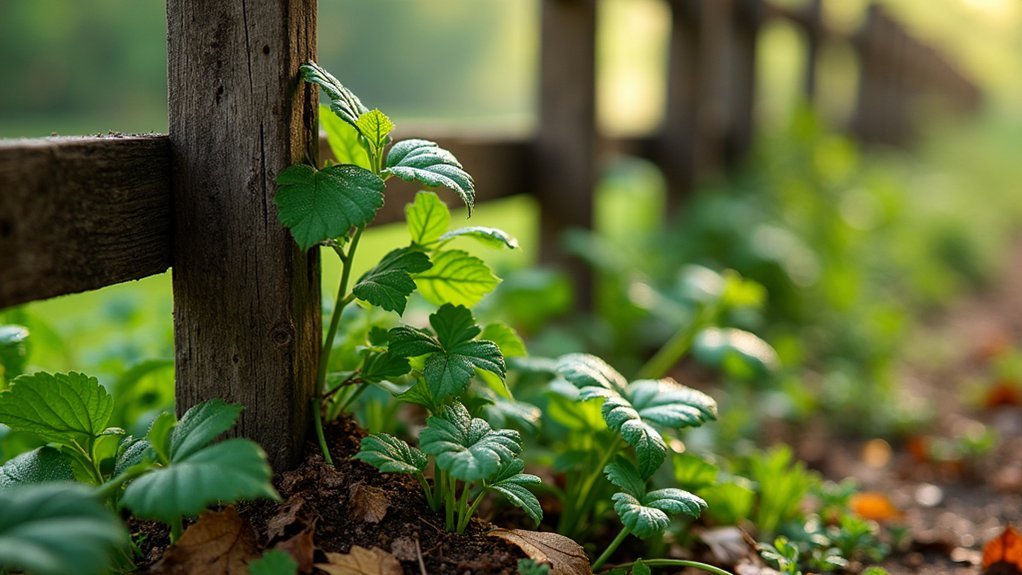A healthy 1:1 root-to-shoot ratio creates structurally sound living fences. Maintain this balance by pruning during dormant seasons, removing only 20-30% of foliage at once. Select deep-rooted native species like hawthorn or elderberry, and prepare your site with well-drained, organic-rich soil. Regular maintenance prevents post instability and encourages dense root development. Proper drainage and strategic pruning will extend your fence’s lifespan substantially. The strongest fences grow from what you can’t see.
The Science Behind Root-to-Shoot Ratios in Living Fences

Balance is the cornerstone of successful living fences. When you’re establishing these natural barriers, understanding the root-to-shoot ratio is essential for long-term stability. Research shows a 1:1 ratio often provides ideal structural integrity, ensuring sufficient root mass supports above-ground growth.
Your plant species selection greatly impacts this balance. Deep-rooted varieties offer superior anchorage and resilience compared to shallow-rooted alternatives.
As you maintain your living fence, remember that regular pruning doesn’t just shape appearance—it actively encourages denser root system development. This enhanced root network improves soil stability and reduces erosion while strengthening your fence’s foundation against environmental stresses.
Selecting Plant Species for Optimal Underground Support
When choosing plants for your living fence, the strength of what lies beneath the surface often determines its long-term success.
You’ll want species with extensive root systems that enhance soil stability while preventing erosion around fence posts.
Consider these options for ideal underground support:
- Deep-rooted species like wisteria and hawthorn provide exceptional support by anchoring soil firmly around posts.
- Native plants adapted to local conditions create effective root systems that minimize soil shifting and settling.
- Perennials such as elderberry and blackthorn combine fibrous roots with dense privacy hedges.
- Climbing plants like clematis distribute weight evenly across the fence structure.
Don’t overlook maintenance—regular pruning and health monitoring guarantee your chosen plants maintain the root-to-shoot balance necessary for long-term fence stability.
Site Preparation Techniques to Encourage Strong Root Development

You’ll need to test your soil composition before planting to identify deficiencies and determine the proper amendments for thriving root systems.
Ensuring proper drainage through techniques like raised beds or adding coarse materials prevents devastating root rot that can undermine your living fence’s stability.
Treating the ground before digging with organic matter and appropriate pH adjustments creates an ideal growing environment that encourages roots to spread deeply and anchor your fence securely.
Test Soil Composition First
Before establishing plants to support your fence structure, testing the soil composition will reveal critical information about pH levels, nutrient profiles, and texture characteristics. This knowledge serves as your foundation for creating ideal root development conditions that will anchor your living fence securely.
- Collect soil samples from multiple locations along your planned fence line to identify variations in soil types and nutrient availability.
- Check drainage capacity by digging a small hole, filling it with water, and monitoring absorption rate—proper drainage prevents rot and strengthens root systems.
- Assess organic matter content which directly impacts your plants’ ability to develop strong root growth.
- Measure pH levels to determine if you’ll need amendments—most fence-supporting plants prefer slightly acidic to neutral soil (6.0-7.0).
Drainage Prevents Root Rot
After understanding your soil’s unique composition, proper drainage emerges as the foundation for vigorous root development. When installing fence posts, you’ll need to prevent root rot by ensuring water doesn’t accumulate around the base. Incorporate organic matter to improve soil structure and create conditions that promote healthy growth.
| Drainage Technique | Benefits | Maintenance Needs |
|---|---|---|
| Raised post holes | Prevents water pooling | Regular soil checks |
| Gravel base layer | Enhances moisture flow | Minimal upkeep |
| Drainage tiles | Redirects excess water | Seasonal inspection |
Don’t underestimate the importance of mulching around your posts to balance moisture retention while allowing excess water to drain away. Make drainage a priority in your site preparation, and you’ll establish fence posts with robust root systems that withstand environmental challenges.
Pre-Dig Ground Treatment
Successful root development begins long before you break ground for your fence posts. Proper pre-dig ground treatment establishes the foundation for robust root growth and guarantees your fence’s long-term stability.
Achieve ideal soil quality for strong root development by:
- Testing soil pH and nutrient levels to determine what amendments your specific site requires.
- Incorporating organic matter like compost or well-rotted manure to improve soil structure and fertility.
- Addressing soil compaction through aeration, which enhances drainage and creates pathways for roots to penetrate deeply.
- Applying a protective mulch layer that regulates temperature, retains moisture, and suppresses competing weeds.
Don’t overlook these preparation techniques—they’re as essential as the fence posts themselves.
When your supporting plants develop healthy root systems, they’ll anchor your fence securely for years to come.
Planting Methods That Balance Growth Above and Below Ground

While creating a living fence requires attention to the visible elements that form its structure, the hidden foundation beneath the soil ultimately determines its strength and longevity.
To achieve an ideal fence, plant at the correct depth—about 1 inch for smaller plants like morning glory and 1-2 inches for larger species like wisteria. You’ll encourage strong root systems by using well-drained soil enriched with organic matter, which supports healthy foliage while roots establish deeply.
Don’t overlook regular pruning of above-ground growth, as this redirects energy to root development, creating a more balanced structure.
Implement companion planting by pairing deep-rooted species with shallow-rooted ones to enhance soil stability. When possible, include native species that are already adapted to local conditions.
These planting techniques create living fences with the perfect balance both above and below ground.
Pruning Strategies to Maintain Ideal Root-to-Shoot Proportions
You’ll achieve healthier fence plants by timing your pruning during dormant seasons, which reduces stress and promotes balanced spring growth.
Cut no more than 20-30% of foliage at once to maintain the critical balance between visible growth and the developing root system below.
Thin out crowded branches strategically to improve sunlight penetration, which strengthens roots and creates a more stable, proportional fence plant structure over time.
Seasonal Cutting Techniques
To maintain an ideal root-to-shoot balance in your living fence, proper seasonal pruning is crucial. Late winter or early spring cutting removes excess growth and encourages robust root development before the growing season begins. This maintenance requirement prevents overgrowth that weakens your living fence’s structural integrity.
- Remove no more than one-third of total shoot growth in a single session to prevent shock and maintain long-term health.
- Thin out crowded branches to improve light penetration and air circulation, fostering a healthier root system.
- Implement species-specific techniques, such as aggressive cutting for vigorous plants like wisteria or honeysuckle.
- Schedule regular pruning every one to two years to guarantee your fence’s energy is directed toward strengthening roots instead of producing excessive top growth.
Root-Supporting Trim Patterns
Achieving ideal root-to-shoot proportions requires strategic pruning patterns that specifically nurture your fence’s foundation. Your pruning strategies should maintain a balanced root-to-shoot ratio, ensuring the root system can support the fence’s above-ground growth.
Implement seasonal pruning in late winter or early spring to remove old wood and encourage healthy new shoots. This timing allows plants to direct energy toward strengthening their root system before the growing season begins.
Practice selective thinning to improve air circulation and light penetration, which enhances overall plant vigor.
Seasonal Maintenance for Long-Term Fence Stability

Maintaining the stability of your fence throughout the changing seasons requires diligent attention to potential threats that emerge with each weather shift. Your fence posts face different challenges as temperatures fluctuate and moisture levels change, making seasonal maintenance essential for preventing rot and structural failure.
- Inspect posts for rot in spring and fall, applying wood preservatives before winter to protect against decay.
- Monitor drainage patterns after heavy rains or spring thaw to prevent water pooling around posts.
- Prune surrounding vegetation in autumn to reduce moisture retention and improve air circulation.
- Add gravel or drainage solutions at post bases to direct water away, especially important in regions prone to frost heave.
Don’t wait until posts wobble—preventive maintenance extends your fence’s lifespan considerably.
Troubleshooting Common Root System Issues in Established Fences
When your established fence begins showing signs of instability, the culprit often lies hidden beneath the soil where competing root systems wage a silent battle.
You’ll need to check for invasive roots that might be undermining your fence posts’ stability.
Look for signs of poor drainage around post bases, which can accelerate rot. Implement drainage solutions like gravel beds to protect post integrity.
If you notice leaning posts, inspect for overcrowded root systems competing for nutrients that can weaken your fence’s foundation.
Don’t overlook soil erosion or compaction, as both conditions stress posts and supporting plants.
Regular maintenance, including strategic pruning of nearby plants, helps manage root growth.
When replacing or adding plants, select species with non-invasive root systems to prevent future issues and extend your fence’s lifespan.
Frequently Asked Questions
How Do I Make My Fence Less Wobbly?
To make your fence less wobbly, bury posts deeper (1/3-1/2 of length), secure with concrete or gravel, check for soil erosion, choose proper post size, and install below frost line in cold climates.
What Is the Rule of Thumb for Fence Post Depth?
You’ll want to bury one-third to one-half of your fence post underground. For a standard 6-foot fence, dig 2-3 feet deep. Always set posts below the frost line in cold climates.
How to Stop Burglars Jumping Over Fences?
You’ll deter burglars by installing 6+ foot fences with anti-climb features like spikes. Plant thorny bushes at the base, use durable materials, and maintain the area by trimming potential hiding spots regularly.
How Do You Keep a Fence Level on Uneven Ground?
You’ll need to use a level for each post and try the step method, where you follow the ground’s contour. For steep slopes, create terraced sections with posts at different heights, ensuring each segment remains level.
How to Make a Fence Stable?
To make a fence stable, you’ll need to bury posts at proper depth (one-third to one-half underground), use concrete for anchoring, choose appropriate post sizes for your conditions, and maintain good drainage around posts.
In Summary
You’ve learned that a strong living fence requires the right balance between roots and shoots. By selecting appropriate species, preparing your site properly, and maintaining consistent pruning routines, you’ll develop sturdy below-ground support for your above-ground barrier. Don’t neglect seasonal care—it’s essential for long-term stability. When problems arise, address them promptly to preserve the fence’s structural integrity and lifespan.





Leave a Reply